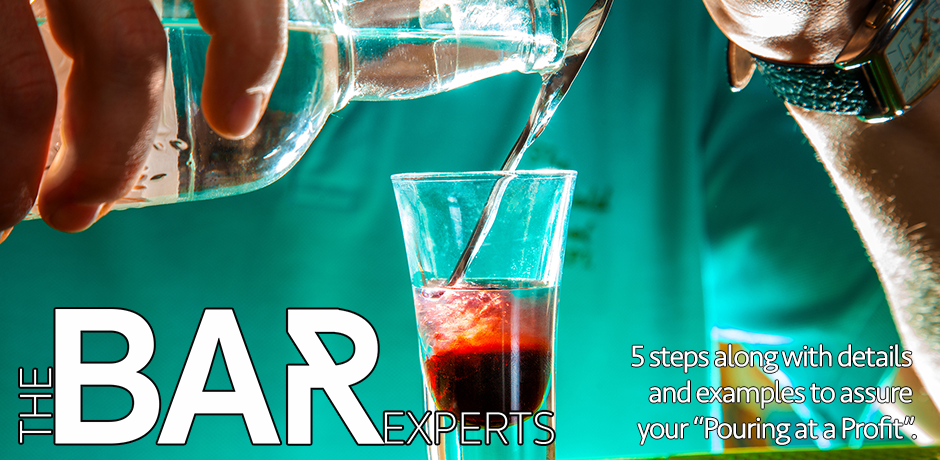Pouring Cost
Pouring Cost
Your Pouring Costs are one of the most crucial parts of a success Bar, Restaurant, Nightclub or Entertainment Venue. Here are 5 Steps along with details and examples to assure your Pouring at a Profit
You’ve probably read article after article of people preaching about how to control your pouring costs. They claim you can fix it by watching your bartenders pours, changing your pricing and following a simple math formula.
Actually it’s not that simple. In this article, I will outline 5 steps I have used over the years in retaining some of the industry’s lowest pour costs.
- Control your bartender’s pours
- Limit the products you carry
- Control your unit cost by controlling your free products
- Perpetual “Detailed” Inventory Tracking
- Order based on “Usage” (Not based on Par)
Industry experts have said, time and time again, the average Combined Pour Cost is somewhere between 18% to 28% They get these figures by using the following formulas… Cost of Goods divided by Retail Sale Price equals the Pour Cost.
Example:
- 11% for liquor ($0.40 cost / $3.50 sale = 11% pour cost)
- 25% for bottled beer ($0.63 cost / $2.50 sale = 25% pour cost)
- 33% for wine ($1.68 cost / $5.00 sale = 33% pour cost)
However, Bars and Pubs operating with lower drink prices will have a higher CPC where as Nightclubs and Adult Clubs operating with higher drink prices and bottle service will have a lower CPC prix cialis en france.
The first thing you have to do is decide what’s a profitable CPC for your type of business, operating in the market that you’re in. That part I’ll leave up to you.
I was recently operating a 1500 occupancy Nightclub in Las Vegas with an average CPC of 6.5% (That’s 50% lower then the industry average). 10% of our sales came from bottle service, the average drink price was $10.00, and the nightclub was open 7 days a week. That being said, operating at a 6.5% CPC with those variables, is truly considered Pouring at a Profit…
Below you will find the 5 steps along with details and examples that I would take each and every week to assure that my property was indeed “Pouring at a Profit”.
5 Steps Towards “Pouring at a Profit”
1 – Control your bartenders pours
- Pour test your bartenders prior to each and every shift
- Change your pour test periodically
- Change your pour size
- Change the flow of your pour spout and
- Change the bottle you use for testing
2 – Limit the products you carry. (My menu consisted of the following)
- Vodka’s – Grey Goose, Stolichnaya (Elit, Vanilla, Raspberry, Blueberry, Orange), Absolute, Ketle One, Belvedere (Bottle Service Only), Sky (Bottle Service Only) and El CuCuy (Well)
- Bottle Beer – Amstel Light, Budweiser, Budlight, Coors Light, Corona, Heineken, Michelob Ultra, New Castle and Stella
- Gin – Bombay Sapphire, Crystal Palace (Well) and Tanquery
- Rum – Bacardi (Superior and 3 flavors), Captain Morgan, Ron Rio (Well) and Sailor Jerry
- Scotch – Chivas, Dewars and Johnny Walker Black
- Bourbons / Whiskeys – Crown Royal, Jack Daniels, Jameson, Jim Beam, Makers Mark, Northern Light (Well) Seagrams, Southern Comfort and Wild Turkey
- Cognac – Courvoisier V.S, Hennessey VSOP
- Cordials – Dekuypers (11 Flavors), Chambord, Cointreau, Disaronno, Frangelico, Goldschlager, Grand Marnier, Hypnotic, Tuaca, Kahlua, Midori, Jagermeister, Rumplemintz
- Champagne / Sparkling Wine – Cristal, Dom Perignon, Vueve Cliquot, Kenwood (Well)
3 – Control your unit cost by controlling your free products.
- Liquor distributors always have free product promotions and usually give you whatever they want to see on your back bar.
- Always request free products only of those products you are currently ordering.
Example: If Bacardi is running a promotion where for every case of Bacardi you order, they give you a free bottle of a flavored Bacardi. I would only accept the flavors that I was currently stocking. This kept my back bar clean from having 12 different Bacardi flavors and more importantly this lowered my bottle unit cost for that product.
Perpetual “Detailed” Inventory Tracking
(Your weekly inventory tracking should include.
- Case Cost
- Unit Cost
- Cost per Serving
- Beginning Inventory Units
- Beginning Inventory $ Value
- Weekly Purchase Units
- Weekly Purchase $ Value
- Weekly Received Units
- Weekly Received $ Value
- Total On Hand Units
- Total On Hand $ Value
- Consumed Units
- Consumed $ Value
- Comps
- Discounts
- Spill Rate
- Ending Inventory Units
- Ending Inventory $ Value
- Total Usage
- POS Tracking
- Variance
Order based on “Usage” (Not based on Par)
Most operators place their orders based on a Par guide. Leaving you with broken case orders and unnecessary stock sitting in your liquor room. (Unnecessary unused stock raises your risk of employee theft as well as breakage and an inflated pouring cost)
I placed my orders every week based on what I sold and my upcoming projections, not what my par stock was.
These steps will help you order more precisely, clean up you back bar, limit your risk of theft and help control your pour costs to assure your venue is Pouring at a Profit. We’ve given you the tricks – now go work your magic!







Leave a Reply
Want to join the discussion?Feel free to contribute!